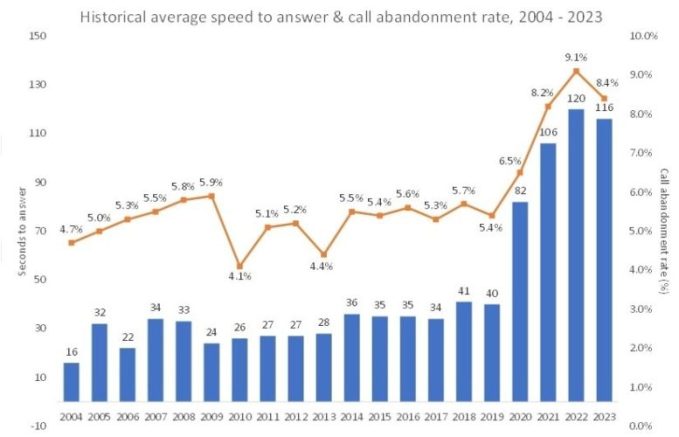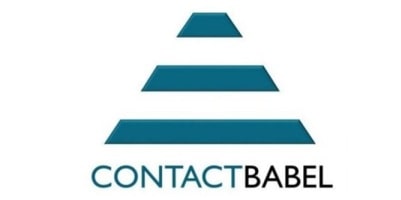Contact centre queue length quadruples since 2013, driving poor CX
 Based on surveys with 1,000+ UK customers and hundreds of UK contact centres, “Exceeding UK Customer Expectations” is the latest research report from ContactBabel.
Based on surveys with 1,000+ UK customers and hundreds of UK contact centres, “Exceeding UK Customer Expectations” is the latest research report from ContactBabel.
It provides insight into what’s driving UK customer decisions, identifies the frontline issues that most impact on customer experience and advises businesses on the solutions available to solve them.
There is no great surprise that the most widely reported customer issue is that the queue time / speed to answer is too long.
Looking at segmentations by age group, older customers are more likely to report long queue times happening very often, with almost half of over-55-year-olds stating this to be the case.
Customer Issue: “The queue time is too long” (by age range)

As the following chart shows, customers are not imagining that the average speed to answer is excessive: the industry statistics bear this out.
Speed to answer plays a vital part in improving the customer experience, and also feeds into other performance measures such as call abandonment rate: obviously, the longer the queue, the more people will abandon the call.
The following chart shows historical figures for average speed to answer and call abandonment rate.
The huge uptick in 2020 and 2021 was caused by pandemic-related working practices and an increase in demand experienced by some businesses.
Despite a return to normality, speed to answer remains extremely high compared to the historical norm.
Call abandonment rate did not show any upward trend until the pandemic, but has tracked upwards, driven by speed to answer.
This is clear proof that customers are not overexaggerating their frequent experiences with long queue times.
It is also worth noting that customers’ perceptions of how long they have been queueing are far higher than reality: past ContactBabel research asked customers to estimate their typical wait time, which was reported to be 23 times higher than the actual industry average, showing that the effect of queue times on customer experience is exceptional.
Historical average speed to answer & call abandonment rate, 2004 – 2023

Along with first-contact resolution, short queue times are reported by customers to be the main drivers of customer experience.
However polite and empathetic your agents are, many callers arrive into the conversation with a frustrated and negative mindset.
So what can be done?
Queue lengths are heavily affected by the length of the call: quite simply, agents who are already on calls can’t be taking new ones.
And as more of the simple work goes to self-service, the average call is longer and more complex: the typical service call takes 48% longer than in 2013.
Enlightened operations regard the call duration metric with wariness: a call which is cut short too quickly can often mean a worse experience for the customer (with lower revenues over time), lower first-call resolution rates (which increase costs in the long-term) and fewer cross-selling or upselling attempts being made.
Yet there are numerous opportunities to cut call lengths without damaging customer outcomes or quality.
We are starting to see AI being used for applications other than chatbots, and would expect these technologies to be increasingly applied to solving this problem, with all parts of the call ripe for trimming:
– Call routing: AI can provide an instantaneous gathering and assessment of data from multiple sources to occur even before the call is routed, allowing accurate prioritisation and delivery of the call, helping agents by matching skills and requirements, and providing them with information as the call goes live.
– Customer identification and authentication: 76% of inbound calls to UK contact centres require caller identity verification. This takes an average of 44 seconds per call, which is 10.5% of a typical call’s length.
AI-enabled voicebots can take customers through security, reducing costs while providing a similar level of customer identification to live agent authentication, and has real potential to improve both productivity and agent morale.
– Talk time: within calls, time can be wasted by searching for the right information; accessing multiple applications and screens; repetition due to mishearing; pauses for agents to type; and reading long terms and conditions to customers.
AI can assist the agent throughout the call, providing suggestions and data, writing to multiple databases in the background and even making the conversation sound clearer for both sides.
– Post-call wrap-up: on average, 20% of a call’s overall length is spent on post-call work, including coding call dispositions, writing notes, updating databases and initiating business processes.
This can onerous and prone to error: AI can ensure consistency of data, initiate the correct back-office processes and automatically generate call notes.
While recent years have seen the UK contact centre industry lose tight control of operational metrics to some extent, AI offers the chance to win this back, both through reducing unnecessary cost and also improving customer experience, satisfaction and loyalty.
![]()
“Exceeding UK Customer Expectations 2024-25” is available for free download by Clicking Here
 ContactBabel is the contact centre industry expert, helping US and UK contact centres compare themselves to their closest competitors so they can understand what they are doing well, what needs to improve and how they can do this.
ContactBabel is the contact centre industry expert, helping US and UK contact centres compare themselves to their closest competitors so they can understand what they are doing well, what needs to improve and how they can do this.
Our ongoing primary research helps businesses understand how technology, people and process best fit together, and how they will work collectively in the future.
For additional information on ContactBabel view their Company Profile
